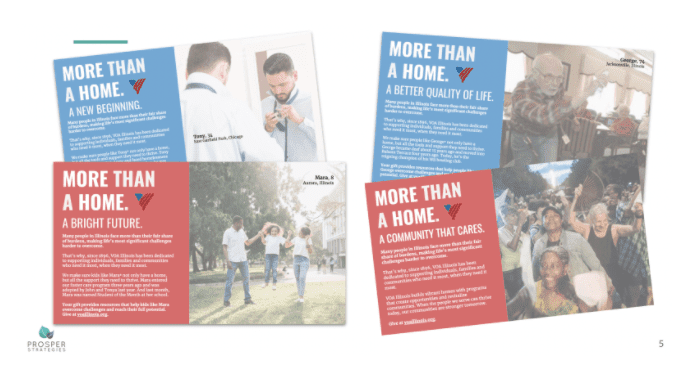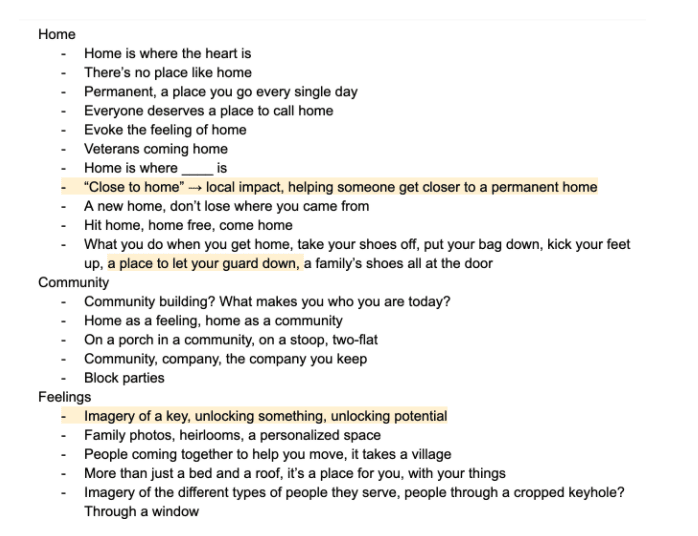Every nonprofit has multiple stakeholder groups, ranging from board members to corporate partners to communities served, and often your messaging may need to vary from one audience to another. So how do you effectively tailor your messaging, while maintaining brand cohesion across your marketing and fundraising channels, including social media, direct mail, advertisements, emails and more? By using a nonprofit campaign concept.
A nonprofit campaign concept example
One of my favorite nonprofit campaign concepts was for Volunteers of America – Illinois (VOA-IL). When we began our work with the organization, many were mistaking VOA-IL for a volunteer-based organization that served primarily veterans. The fact is that it serves people of all ages and walks of life and is made up of a staff of full-time professionals in social work, mental health, child welfare, housing and more. The nonprofit needed new messaging to better describe their breadth and depth of services as well as to reach new donors, partners and funders.
[bctt tweet=”How do you effectively tailor your messaging, while maintaining brand cohesion across your marketing and fundraising channels, including social media, direct mail, advertisements, emails and more? By using a nonprofit campaign concept.” username=”ProsperStrat”]We began by developing a new Reason for Being for VOA-IL and then crafted new messaging for each one of their stakeholder groups. Then, we helped them create their campaign concept, “More than a home,” to tie everything together across audiences and channels.
“More than a home,” was based on input from research and insights from VOA-IL’s stakeholders, and it was designed to incite the idea that across all of the organization’s service areas, VOA-IL was a home for many, but it was also so much more – it was “A New Beginning,” “A Bright Future,” “A Better Quality of Life,” and “A Community that Cares.”
Today, VOA-IL uses the campaign concept in all of their marketing and fundraising materials, so whether a person watches one of their videos or receives an email, it’s easy to identify that it’s coming from VOA-IL.
How to develop a nonprofit campaign concept
Nonprofit campaign concepts should be developed with insights from your nonprofit’s stakeholders, including the individuals and communities you serve. Surveys, interviews and focus groups can be a great way to get initial insights from various audiences that will help you shape your concept. It’s also important to have an understanding of your nonprofit’s ecosystem, so you’re clear on how your organization is similar or different from others.
[bctt tweet=”Nonprofit campaign concepts should be developed with insights from your nonprofit’s stakeholders, including the individuals and communities you serve.” username=”ProsperStrat”]When beginning to develop your nonprofit campaign concept, use this research and information to define the objective you’re looking to achieve with it, i.e. “We want to communicate to our donors and corporate partners that we’re not just a veterans services organization, while most importantly, representing those we serve authentically and respectfully.” Becoming clear on your campaign concept’s objective then ensures everyone can begin brainstorming with the same endpoint in mind.
Then, start by throwing out any words or phrases on the tip of your tongue. This can create quite the mashup of thoughts, but it’s important to remember that no idea is a bad idea. One word or concept can open up a whole new world of opportunities and thinking.
A campaign concept can be descriptive or evocative. Once you’ve conducted your initial brainstorm, determine what feels most true to your organization, by grouping your words, phrases and ideas thematically. Discuss which themes rise to the top and conduct another brainstorm focused on those themes.
Finalizing your nonprofit campaign concept
As you begin to home in on your nonprofit campaign concept, determine not just the words you will use, but also the colors and imagery. Then, put together initial designs and go to your stakeholders again for feedback. As with your research phase, you can do this through focus groups or listening sessions, where you ask people a specific set of questions on areas where you’re looking to receive feedback. You want to ensure that any concept you choose makes those you serve feel proud of their association with your organization and that if you’re representing them or their experiences, it’s done in a way that’s true and authentic.
Once you’ve received inputs and finalized your nonprofit campaign concept, it is important to bring it to life across all of your various marketing and fundraising materials. This includes your website, social media pages, emails, advertisements, direct mail pieces and more.


